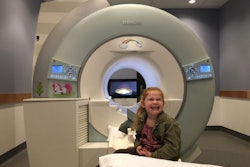
A new study from Johns Hopkins Hospital found that requiring pediatric patients to undergo child life consultations prior to an MRI scan significantly reduced the need for anesthesia to keep the children from fidgeting during the exam, according to a study published online April 22 in the Journal of the American College of Radiology.
The child life program at Johns Hopkins helped reduce the use of anesthesia from 23%, when child life consultations were performed by referral only, to 19%, when counseling became mandatory. Even more prominent was the change in anesthesia use among children 5 to 10 years old, which dropped from 45% to 35% based on the same criteria.
Perhaps most intriguing is that the reduction was accomplished without the use of high-tech gadgetry, such as video goggles or screens, to keep the patients occupied.
 Dr. Daniel Durand, adjunct assistant professor of radiology in the division of pediatric radiology.
Dr. Daniel Durand, adjunct assistant professor of radiology in the division of pediatric radiology."Not to take anything away from those things, but the downside is how the radiology community thinks about child life, because that might be the only exposure some folks have," lead author Dr. Daniel Durand, an adjunct assistant professor of radiology in the division of pediatric radiology, told AuntMinnie.com. "We found that you don't necessarily need those things to get good results."
Rising use of MRI
MRI is increasingly being used in pediatric cases due to concerns about exposing young patients to radiation, especially from CT scans, the authors wrote. However, because MRI exams take longer, general anesthesia is sometimes needed. The disadvantage is that there are medical risks and increased costs associated with using MRI instead of other modalities (JACR, April 22, 2015).
Relative to cost, Durand and colleagues noted one previous study which found that the use of general anesthesia in pediatric MRI increased mean visit time by one hour and 46 minutes, with a subsequent rise in labor cost per case (Radiology, July 2010, Vol. 256:1, pp. 229-237).
"Some are skeptical about MRI because the imaging scan takes longer and the results can be affected by motion artifacts," senior author Dr. Thierry Huisman, Johns Hopkins' medical director of pediatric radiology and director of pediatric neuroradiology, told AuntMinnie.com. "However, I think eventually many studies that are done on CT can be replaced by ultrafast MRI and child life [consultation]."
To alleviate potential anxiety and fear of the unknown, pediatric patients and their families meet with a certified child life specialist (CCLS) before the MRI scan.
Mollie Young has been the lone child life specialist in Johns Hopkins' radiology department for the past 2.5 years (other departments in the hospital have child life staff). Child life specialists are "sort of a hybrid between a counselor and a teacher," Young told AuntMinnie.com.
Before the scan date, Young provides details for the patient and his or her family about what to expect on the day of the exam. She then meets the patient and family at registration and coordinates and follows their entire visit. She also discusses coping mechanisms the patient can use during the scan to stay calm.
 Mollie Young, certified child life specialist.
Mollie Young, certified child life specialist."We want our kids to be as safe as possible, and we want them to walk away from the experience having had a good time, so we pair them with our child life specialist as their buddy for the day," Durand said. "You get a lot of the currency out of child life just by being a pleasant person who can engage the patient, be in that moment with them and their family, and take the time to explain the procedure."
After conferring with the family and speaking with and observing the child, Young is the person who decides whether the child is able to undergo an MRI scan without anesthesia. She said she can usually tell "within a couple of minutes" if the patient can stay still long enough for a scan.
If a child is overly active, it does not necessarily mean that he or she will be an uncooperative patient. Young evaluates "their temperament, the way they follow instructions, how they like to participate, and especially their [previous] healthcare experiences," she said.
"Sometimes kids will come in bouncing off the walls," she added. "The technologist will look at me and say, 'Do you really think this kid is going to do it?' And I say, 'I promise you they will do it.' "
Young can also overcome the challenge of a child having attention-deficit/hyperactivity disorder (ADHD).
"It is helpful to have certain things in place, such as listening to relaxing music or having a family member stay in the room with them," she said. "We know what the driving forces are to get the kids to get through an MRI."
For children who have had MRI scans with anesthesia in the past, "not wanting that mask to help them fall asleep is enough of a driving force in itself for them to hold still," Young said.
Before and after
To assess the efficacy of mandatory child life consultation, the researchers started with a baseline period of December 2011 to November 2012, when patient evaluations and interventions were done solely at the request of the referring physician.
Durand and colleagues then established an intervention period of December 2012 to November 2013. During this period, all patients ages 5 to 18 years who were scheduled for an MRI scan of less than 60 minutes received mandatory child life evaluation to determine if general anesthesia was necessary.
 Dr. Thierry Huisman, medical director of pediatric radiology and director of pediatric neuroradiology.
Dr. Thierry Huisman, medical director of pediatric radiology and director of pediatric neuroradiology.During the baseline period, 564 (23%) of 2,433 MRI patients who were eligible to see a child life specialist underwent general anesthesia. When child life consultation became mandatory (the intervention period), the number of patients undergoing general anesthesia dropped to 484 (19%) of 2,526 cases.
"The difference in general anesthesia use between the time periods was highly significant, with an absolute reduction of 4.02% and a relative reduction of 14.18%," the authors wrote.
Patients between the ages of 5 and 10 years benefited most from the new mandate. In this group, 435 (45%) of 958 patients received general anesthesia during the baseline period, compared with 368 (35%) of 1,040 patients in the intervention period.
Among patients 11 to 18 years of age, 129 (9%) of 1,427 underwent general anesthesia during the baseline period, compared with 116 (8%) of 1,486 during the intervention period. The difference in this age group was not significant, according to the researchers.
No surprises
Durand and colleagues said they were not surprised by the positive results from the child life program.
"We are blessed to have a really good child life specialist, and I know the interventions do not have to be high-tech because I have seen [Young] work her magic," Durand said.
Going back five years or so, Durand said his perception of child life counseling "was more about throwing flashy whistles, bells, and gadgets at these kids to keep them amused in the scanner, rather than thinking of child life as sort of a human-driven intervention in a teamwork approach."
"I think you can have all that stuff, but if you don't have child life [consultation], I am not sure how much mileage you get out of it," he said.
To help young patients acclimate to the MRI environment, Johns Hopkins recently installed a full-size mock MRI scanner. It makes the same noise as a fully operating system, but there is no magnet in the facsimile.
"We don't have to screen the whole family to see if they have pacemakers or metal implants, and we don't have to have a technologist, which is much more expensive, onsite," Huisman said. The child life specialist "can run the show by herself."
Typically, pediatric patients are given a five-minute test run in the mock scanner to see if they can stay still during that time. Previous studies have shown that if a child can remain quiet and motionless for those five minutes, the great majority of actual MRI studies will be successful, Huisman said.
The mock scanner "is not for every kid," Young added. "I think there will be an assessment piece necessary for which kids it will help and which ones it won't."
As for the future, Huisman said Johns Hopkins wants to expand the awareness of the child life consultation program.
"At the moment, we do it with a select group of referring physicians," he said. "We have a very good relationship, they know about the program, and they trust us. But we need to get more out there in the public, and we would like the parents to know about it as well."



.fFmgij6Hin.png?auto=compress%2Cformat&fit=crop&h=100&q=70&w=100)




.fFmgij6Hin.png?auto=compress%2Cformat&fit=crop&h=167&q=70&w=250)











